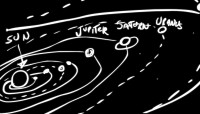
Carolyn rushes home on the train to Helensburgh to do her hobby – searching for planets orbiting other stars, exoplanets. Carolyn doesn't have a telescope but is part of the ever growing band of "citizen" astronomers who search for new planets using their computers...
The search for, and study of, planets orbiting other stars is a rapidly developing field of astronomy, and scientists and engineers based across Scotland are already taking a leading role in this exciting research. Filmmakers have become involved too, working with astronomers to produce two short documentary films to inform and inspire the Scottish public about the search for exoplanets.
‘Into Deep Space’ by Anne Milne and Alberto Iordanov
This film looks at the question of life outside of the solar system, focussing on the work of Dr Duncan Forgan – a theoretical astronomer from the Royal Observatory Edinburgh (ROE) – and Grant Miller, an observational astronomer based at the University of St Andrews. Grant uses the James Gregory Telescope in St Andrews to study exoplanets and part of Duncan’s work involves theoretical calculations and computer simulations – incorporating the latest exoplanet data – to improve our understanding of how and where we might expect to see life appearing in the Galaxy.
ECA student Alberto Iordanov said: “What an incredible journey into space! This film made me appreciate where we stand in the vast universe around us. It was a unique experience that I will remember for the rest of my life.”
“It's essential for scientists to step back from their research once in a while, and explain clearly to the public why what they're doing is important. Being in this film has really brought home to me the impact of what Scottish scientists are achieving in a very exciting field of astronomy.” Dr Duncan Forgan, Royal Observatory Edinburgh
‘Close Distance’ by Stefano Nurra and Florian Schwarz
This is a comparison of the lives of an amateur astronomer, Caroyln Bol, based in Helensburgh who is participating in the citizen science project, ‘Planet Hunters’, and Dr Martin Dominik, Royal Society University Research Fellow at the University of St Andrews. Martin uses a technique called gravitational microlensing to detect small planets orbiting other stars. The film explores the enthusiasm Carolyn, an amateur, and Martin, a professional astronomer, share for the study of exoplanets.
“We share the fascination about the myriads of pinpoints of light on the night sky. A new era of exploring new worlds not only involves professional scientists, but also amateurs, who love what they are doing, and thereby make important contributions.” Dr Martin Dominik, University of St Andrews
From Hoy to Wigtown
Emma Davie, Programme Director in the Film Department at ECA said: “Our students have had their cinematic brains challenged through searching for ways of telling stories in this hugely exciting collaboration. They've been inspired by what they found: a citizen astronomer – a woman from Helensburgh whose hobby is to sit at her computer and find exoplanets; scientists who believe that some sort of life will be found on another planet in our lifetime. How we define ‘life’ is a deeper question though...”
The films are on tour across Scotland until December 2012, and it is expected they will be seen by over 10,000 people from Hoy to Wigtown. They will be shown at a range of venues and events, from Science Centres and Cafés Scientifique, to town halls and local cinemas.
This project is a collaboration between ROE's Visitor Centre, Edinburgh College of Art (ECA), the Universities of Edinburgh and St Andrews and STFC UK Astronomy Technology Centre.
The Royal Observatory Edinburgh Visitor Centre
The ROE Visitor Centre is operated by the UK ATC, an establishment of the Science and Technology Centre. The UK Astronomy Technology Centre is the national centre for astronomical technology, designing and building instruments for many of the world's major ground-based telescopes and space observatories.
Image gallery
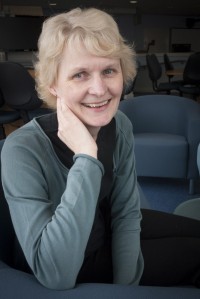
The School's Dr Judy Hardy has won a Higher Education Academy (HEA) Doctoral Programme award to extend her research into the student experience and how it can be enhanced through technology. Her project will investigate the impact and effectiveness of PeerWise, a freely available online tool that enables students to create content in the form of multiple-choice questions and explanations.
Judy has had an active research interest in physics education for many years and was one of the founder members of the Edinburgh Physics Education Research group (EdPER). Recent projects have included studies of students' expectations and experiences of using technology in their early years at university and an investigation of student-generated content for formative and summative assessment tasks.
Innovative teaching
EdPER recently introduced innovative physics teaching based on PeerWise: students can answer and comment on each other’s questions, rate questions or comments, seek help from authors and follow their favourite contributors. Devising problems, reasoning and answers can be much more demanding than ‘merely’ attempting to answer questions. PeerWise is highly engaging and interactive - in some cases students have contributed huge numbers of questions and solutions - and the approach is now being taken up in courses across the University.
Judy's research aims to understand the ways in which these types of student interactions can help promote deep learning and develop high quality problem-solving skills, both key attributes that students need to develop from an early stage in their university careers.
HEA Doctoral Programme
The HEA Doctoral Programme forms part of the Academy’s strategy to undertake research to develop pedagogical knowledge and evidence-based practice in Higher Education. Seven Doctoral studentships are available in the academic year 2012-2013.
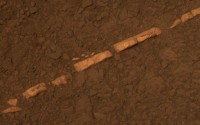
Derek Martin of the School's Physics of Living Matter group explains his work.
My background is in geomicrobiology. I have previously been involved in designing and building equipment for retrieving and sub-sampling deep sea sediment cores whilst retaining in situ pressure. This allows us to be able to manipulate sediments under anaerobic conditions at pressures of up to 1000 times atmospheric pressure.
Sub-surface microbes can be enriched, isolated and characterised without exposing them to atmospheric pressure at any point, giving us the means to attempt to isolate novel piezophiles (microbes requiring increased pressure to grow) and assess the role of microbes in biogeochemical cycles in the sub-surface.
Other areas of my research include investigating the microbial mediation of mineral precipitation; in particular, looking at the ability of bacteria to precipitate carbonates under pressure and their possible use for subsurface engineering in the context of carbon capture and storage.
Planetary simulation chamber
My work at Edinburgh will be to develop and build a planetary simulation chamber to allow us to manipulate the environmental conditions of microbial and geochemical experiments. The purpose of these experiments is to understand the potential for life beyond Earth and to gain insights into microbial physiology.
Initially this work will focus on replicating the conditions on Mars: low temperature, low pressure and high ultraviolet light flux. The intention is to be able to flow relevant fluids through the simulator and investigate the conditions under which microbes will grow, including their interaction with the rock substrate as a possible source of energy.
I will be looking at the possible composition of Mars fluids and whether the conditions have any analogues on Earth, which could help us understand whether life on Mars is possible now, or has been in the past. The intention is to extend these types of studies to the conditions present in the deep sub-surface to help us understand the role of microbes in this environment and the implications for astrobiology. It will also help us understand biogeochemical cycling in the terrestrial subsurface of Earth in the past and present, and also potentially in the future.
About the Physics of Living Matter group
The group's research in this area spans many length and time scales: from aqueous solutions of small bioactive molecules through proteins and DNA to single cells, cell-cell interactions, and collection of organisms in ecosystems, studying phenomena occurring at picoseconds to decades. It uses all three methodologies of physics: experiment, simulation and theory.
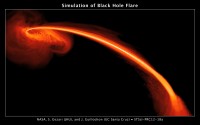
Supermassive black holes, weighing millions to billions times more than the Sun, lurk in the centres of most galaxies. These hefty monsters lay quietly until an unsuspecting victim, such as a star, wanders close enough to get ripped apart by their powerful gravitational clutches.
Astronomers have spotted these stellar homicides before, but this is the first time they can identify the victim. Using a slew of ground- and space-based telescopes, a team of astronomers – led by The Johns Hopkins University in Baltimore and including researchers from the Universities of Edinburgh, Durham and Belfast – has identified the victim as a star rich in helium gas. The star resides in a galaxy 2.7 billion light-years away.
The team’s results will appear in the online edition of the journal Nature on the 2nd of May.
“When the star is ripped apart by the gravitational forces of the black hole, some part of the star’s remains falls into the black hole, while the rest is ejected at high speeds. We are seeing the glow from the stellar gas falling into the black hole over time," research team leader Suvi Gezari, The Johns Hopkins University
“We’re also witnessing the spectral signature of the ejected gas, which we find to be mostly helium," said research team leader Suvi Gezari, of The Johns Hopkins University. It is like we are gathering evidence from a crime scene. Because there is very little hydrogen and mostly helium in the gas we detect from the carnage, we know that the slaughtered star had to have been the helium-rich core of a stripped star.”
This observation yields insights about the harsh environment around black holes and the types of stars swirling around them.
Atmosphere stripped by black hole
This is not the first time the unlucky star had a brush with the behemoth black hole. Gezari and her team think the star’s hydrogen-filled envelope surrounding the core was lifted off a long time ago by the same black hole.
The star may have been near the end of its life. After consuming most of its hydrogen fuel, it had probably ballooned in size, becoming a red giant. The astronomers think the bloated star was looping around the black hole in a highly elliptical orbit, similar to a comet’s elongated orbit around the Sun.
On one of its close approaches, the star was stripped of its puffed-up atmosphere by the black hole’s powerful gravity. The stellar remains continued its journey around the centre, until it ventured even closer to the black hole to face its ultimate demise and was completely disrupted.
Astronomers have predicted that stripped stars circle the central black hole of our Milky Way galaxy, Gezari pointed out. These close encounters, however, are rare, occurring roughly every 100,000 years.
Searching hundreds of thousands of galaxies
To find this one event, Gezari’s team monitored hundreds of thousands of galaxies with the Pan-STARRS1 telescope on Mount Haleakala, Hawaii. Pan-STARRS, short for Panoramic Survey Telescope and Rapid Response System, scans the entire night sky for all kinds of transient phenomena, including supernovae and Near Earth Asteroids, as well as the hoped for star-shredding events.
PanSTARRS was built by astronomers in Hawaii, and is operated by an international consortium, including the astronomers from Edinburgh, Durham, and Belfast. The same patch of sky was watched by GALEX, a space mission measuring ultraviolet light.
The team was looking for a bright flare in ultraviolet light from the nucleus of a galaxy with a previously dormant black hole. They found one in June 2010, which was spotted with both telescopes.
Both telescopes continued to monitor the flare as it reached peak brightness a month later, and then slowly began to fade over the next 12 months. The brightening event was similar to that of a supernova, but the rise to the peak was much slower, taking nearly one and a half months.
“The longer the event lasted, the more excited we got, since we realized that this is either a very unusual supernova or an entirely different type of event, such as a star being ripped apart by a black hole,” said team member Armin Rest of the Space Telescope Science Institute in Baltimore, Md.
By measuring the increase in brightness, the astronomers calculated the black hole’s mass to be several million suns, which is comparable to the weight of our Milky Way’s black hole.
Glowing helium
Spectroscopic observations with the Multiple Mirror Telescope (MMT) Observatory on Mount Hopkins in Arizona showed that the black hole was swallowing lots of helium. Spectroscopy divides light into its rainbow colours, which yields an object’s characteristics, such as its temperature and gaseous makeup.
“The glowing helium was a tracer for an extraordinarily hot accretion event,” Gezari said. “So that set off an alarm for us. And, the fact that no hydrogen was found set off a big alarm that this was not typical gas. You can’t find gas like that lying around near the centre of a galaxy. It’s processed gas that has to have come from a stellar core. There’s nothing about this event that could be easily explained by any other phenomenon.”
The observed speed of the gas also linked the material to a black hole’s gravitational pull. MMT measurements revealed that the gas was moving at more than 20 million miles an hour (over 32 million kilometres an hour). However, measurements of the speed of gas in the interstellar medium reveal velocities of only about 224,000 miles an hour (360,000 kilometres an hour).
“As the object faded, it stayed hot, so we knew it wasn’t a supernova because they cool down. The ultra-fast gas velocity is something we also see in Active Galactic Nuclei – but seeing only helium was like nothing I’ve ever seen in an active nucleus," Andy Lawrence, a team member from the University of Edinburgh.
To completely rule out the possibility of an active nucleus flaring up in the galaxy, the team used NASA’s Chandra X-ray Observatory to study the hot gas. Chandra showed that the characteristics of the gas didn’t match those from an active galactic nucleus.
“This is the first time where we have so many pieces of evidence, and now we can put them all together to weigh the perpetrator (the black hole) and determine the identity of the unlucky star that fell victim to it,” Gezari said. “These observations also give us clues to what evidence to look for in the future to find this type of event.”
Find out more
For images, video, and more information about this study, see:
http://hubblesite.org/news/2012/18
Image gallery
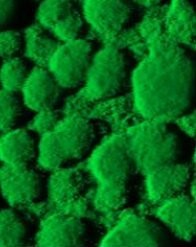
The School's Dr Rosalind Allen is part of an international team of researchers that has been awarded $1.2m to study how bacterial cells self-assemble into 3-D spatially-organized structures. It will also investigate how the different structures influence cooperation within the assembly.
Intercellular cooperation is one of the most important functional behaviours of multicellular assemblies, but from an evolutionary perspective it is also one of the least understood. Experiments and computational modelling will be used to explore self-assembly in Pseudomonas aeruginosa, a common human pathogen that readily forms assembled structures called biofilms.
The team hopes to uncover some of the “design rules” of bacterial self-assembly by manipulating the initial cell configuration of their samples and then tracking how the biofilms form over time. The team will explore, for example, whether certain spatially-structured biofilms are more cooperative and more resistant to invasion by “cheats,” which are cells that reap the benefits of cooperation without paying the costs.
"I am very excited about this grant because it gives us a great opportunity to do really interesting international and multidisciplinary research, which could be relevant not just to how bacteria assemble but also to how biological cells build 3D structures in general." Dr Rosalind Allen, Institute for Condensed Matter and Complex Systems
The P. aeruginosa research will focus on gaining fundamental understanding of how cells assemble into 3D structures, rather than on specific applications. But it is hoped that knowledge of how to design cell assemblies will benefit biotechnology and medicine in the long-term. For example, it might be possible to design surgical implants that are resistant to colonisation by the bacteria that cause chronic infections.
The computational modelling will be carried out by the School's Institute for Condensed Matter and Complex Systems (ICMCS), where it will link with the Institute's ongoing investigation into microbial population dynamics. The work also links to an EPSRC-funded collaboration with Kevin Stratford of EPCC and Davide Marenduzzo of ICMCS, which is developing computational tools for rare event simulations.
The multidisciplinary team is led by Dr Vernita Gordon of the University of Texas at Austin (Physics) and also includes Dr Thomas Bjarnsholt (University of Copenhagen, Microbiology) and Dr Steve Diggle (University of Nottingham, Biomolecular Sciences).
The $1.2m Young Investigator grant was made by the Human Frontier Science Program (HFSP), an international NGO funded by the governments of the G7 nations. HFSP provides research grants to teams of scientists from different countries who wish to combine their expertise to approach questions that could not be answered by individual laboratories. Emphasis is placed on novel collaborations that bring together scientists from different disciplines to focus on problems in the life sciences.
Image gallery
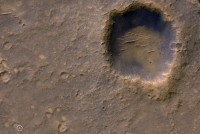
Craters made by asteroid impacts may be the best place to look for signs of life on other planets, a study suggests.
Tiny organisms have been discovered thriving deep underneath a site in the US where an asteroid crashed some 35 million years ago.
Scientists believe that the organisms are evidence that such craters provide refuge for microbes, sheltering them from the effects of the changing seasons and events such as global warming or ice ages.
The study suggests that crater sites on Mars may also be hiding life, and that drilling beneath them could lead to evidence of similar life forms.
“The deeply fractured areas around impact craters can provide a safe haven in which microbes can flourish for long periods of time. Our findings suggest that the subsurface of craters on Mars might be a promising place to search for evidence of life.” Professor Charles Cockell, of the University of Edinburgh’s School of Physics and Astronomy
Researchers from the University of Edinburgh drilled almost 2km below one of the largest asteroid impact craters on Earth, in Chesapeake, US. Samples from below ground showed that microbes are unevenly spread throughout the rock, suggesting that the environment is continuing to settle 35 million years after impact.
Scientists say that heat from the impact of an asteroid collision would kill everything at the surface, but fractures to rocks deep below would enable water and nutrients to flow in and support life. Some organisms grow by absorbing elements such as iron from rock.
The research was published in the journal Astrobiology.
Image gallery
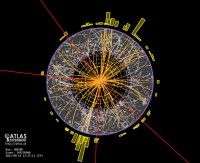
The collision of two 4 TeV proton beams at the LHC’s four interaction points signalled the start of this year's physics data-taking by the LHC experiments. The collision energy of 8 TeV set a new world record, and considerably increases the discovery potential of the LHC.
Although the increase in collision energy is relatively modest, it translates to an increased discovery potential that can be several times higher for certain hypothetical particles. Some such particles, for example those predicted by supersymmetry, would be produced much more copiously at the higher energy. Supersymmetry is a theory in particle physics that goes beyond the current Standard Model, and could account for the dark matter of the Universe.
"Its very exciting. When one is so close to the LHC machine, it is great to see the ramp up going so well." Prof. Peter Clarke, Institute for Particle and Nuclear Physics
Standard Model Higgs particles, if they exist, will also be produced more copiously at 8 TeV than at 7 TeV, but background processes that mimic the Higgs signal will also increase. That means that the full year’s running will still be necessary to convert the tantalising hints seen in 2011 into a discovery, or to rule out the Standard Model Higgs particle altogether.
"The LHC and its experiments are well positioned to have a third year of data-taking at higher energy and at increased collision rates. Members of the Edinburgh ATLAS and LHCb groups were in the pit when the beams were switched on and we will be in the midst of the exciting physics results to come from the 2012 data." Prof. Franz Muheim, Head of the Institute for Particle and Nuclear Physics
“The increase in energy is all about maximising the discovery potential of the LHC,” said CERN Research Director Sergio Bertolucci. “And in that respect, 2012 looks set to be a vintage year for particle physics.”
"We are very excited. During this year we hope to collect enough data for a first real answer on the Higgs Boson's existence. It may still take several years to discover or exclude it, particularly at low mass, and beyond doubt." Phil Clark, Institute for Particle and Nuclear Physics
The LHC is now scheduled to run until the end of 2012, when it will go into its first long shutdown in preparation for running at an energy of 6.5 TeV per beam as of late 2014, with the ultimate goal of ramping up to the full design energy of 7 TeV.
Watch a video about the LHC restart.
Image gallery
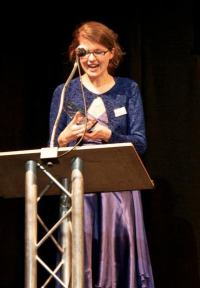
Dr Kristel Torokoff, a lecturer in the School of Physics & Astronomy, has been awarded the Simon Van Heyningen Award for Teaching in Science and Engineering.
One student who nominated Kristel described her as: "Most reliable and dedicated teacher you can encounter. Offers her free time to help and support students that have troubles in particular courses, organizing tutorial on Sunday/Saturdays or during lunch break. Helpful towards everyone, even students that are not in her courses."
"This prize reflects just what bright and hard working students we have in Physics. It's a pleasure to be working with them." Dr Kristel Torokoff
Arthur Trew, Head of the School, said, "The University takes these awards very seriously so to have won is a great achievement for Kristel personally and for the School more generally. To have won it in the difficult area of teaching mathematics is doubly impressive."
Edinburgh University Students’ Association announced the winners at an Oscar-style ceremony in Teviot Row House, hosted by the new University Rector, Peter McColl. Mike Williamson, EUSA VP Academic Affairs, said: "Students have shown their appreciation for good teaching once again. The judging panel was struck by the number of heart-warming comments from students who wanted to thank their lecturers, tutors and support staff. Hopefully the awards will continue to be a success for many years to come."
EUSA's Teaching Awards are in their fourth year, and the scheme is fully supported by the University. Each year has seen thousands of nominations by students of their lecturers, tutors, courses and departments. This year students were also able to nominate teaching support staff, which brought recognition for departmental secretaries, students who support other students' learning through peer-support schemes, and staff who support disabled students in their learning, among others.
Image gallery

Obtaining metallic hydrogen, the Holy Grail of high pressure science, has been a long-standing problem in Condensed Matter Science. The high pressure behaviour of hydrogen has major implications for the interiors of the Jovian planets (the gas giants: Jupiter, Saturn, Neptune and Uranus). High pressure experiments have been driven over the past 70 years not just by the desire to convert the most abundant element in the universe metallic, but through predictions of exotic properties the material may exhibit, such as superfluidity and high temperature superconductivity.
Through new technological breakthroughs in diamond anvil cell experiments, a team of researchers at the Centre for Science at Extreme Conditions at the University of Edinburgh and Geophysical Laboratory, Washington DC have not only set a pressure record for the compression of hydrogen at room temperature but discovered a new phase - one of only four known phases - at conditions that exceed 2.2 million times atmospheric pressure.
"This interesting new phase is exemplary of how pressure can introduce complexity in an element otherwise thought as simple and provides a continuous, elegant pathway to the metallization of hydrogen. These are exciting times in high pressure hydrogen research and the discovery of a new phase will without doubt stimulate further studies and drive experiments in obtaining the elusive metallic state." PhD student Ross Howie, the first author on the Physical Review Letter where the discovery is reported.
The new phase consists of 'honeycomb' layers between which unbound molecules intersperse. Such a structure is highly unusual, exhibiting a mixture of both atomic and molecular properties. Predictions (Pickard and Needs, 2007) suggest this phase will evolve if further compressed, electrically conducting along the honeycomb layers much like graphite. Despite reaching 3.2 million times atmospheric pressure at room temperature, the metallic state is still to be attained. Nonetheless, as it was previously thought that hydrogen would become conducting in either the pure atomic or pure molecular state, this study is crucial in the understanding of the nature of metallic hydrogen.
Image gallery
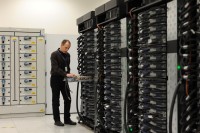
Powerful supercomputers have shed light on the behaviour of key sub-atomic particles, in a development that could help explain why there is almost no anti-matter in the Universe.
An international collaboration of scientists, including physicists from the Universities of Edinburgh and Southampton, has reported a landmark calculation of the decay of an elementary particle called a kaon, using breakthrough techniques on some of the world’s fastest supercomputers.
The calculation took 54 million processor hours on the IBM BlueGene/P supercomputer at the Argonne Leadership Class Facility (ALCF) at Argonne National Laboratory in the US.
The new research, reported in the March 30 issue of Physical Review Letters, represents an important milestone in understanding kaon decays - which are a fundamental process in physics. It is also inspiring the development of a new generation of supercomputers that will allow the next step in this research.
“It has taken several decades of theoretical developments and the arrival of very powerful supercomputers to enable physicists to control the interactions of the quarks and gluons, the constituents of the elementary particles, with sufficient precision to explore the limits of the standard model and to test new theories,” says Chris Sachrajda, Professor of Physics at the University of Southampton, one of the members of the research team publishing the new findings.
“The present calculation focuses on the fundamental question of how we arrived at a universe composed almost exclusively of matter with virtually no antimatter, but the theoretical and computational techniques of Lattice Quantum Chromodynamics (see below) will also be central to unraveling the underlying framework behind the discoveries anticipated at the Large Hadron Collider at CERN.”
The next generation of IBM BlueGene/Q machines is expected to have 10 to 20 times the performance of the current machines:
“With this dramatic boost in computing power we can get a more accurate and complete version of the present calculation, and other important details will come within reach, " said Dr Peter Boyle, University of Edinburgh. "This is a nice synergy between science and the computer — the science pushing computer developments and the advanced computers pushing science forward, to the benefit of the science community and also the commercial world.”
The process by which a kaon decays into two lighter particles known as pions was explored in a 1964 Nobel Prize-winning experiment. This revealed the first experimental evidence of a phenomenon known as charge-parity (CP) violation — a lack of symmetry between particles and their corresponding antiparticles that may explain why the Universe is made of matter, and not antimatter.
When kaons decay into lighter pions, the constituent sub-particles known as quarks undergo changes brought about by weak forces that operate at such a small scale. As the quarks move away, they exchange gluons – particles that cause the quarks to bind into the pions.
The computations are performed using the techniques of lattice quantum chromodyamics (QCD: the theory that describes fundamental quark-gluon interactions), in which the decay is input into a computer as a finite grid of space-time points. The problem of calculating the decay rate can be reduced to a statistical method, called the Monte Carlo method. The present calculation extends the range of lattice QCD calculations to a new class of process, weak decays with two strongly interacting particles in the final state.
Whilst the calculation reported here has determined fundamental quantities necessary for an understanding of the matter-antimatter asymmetry, it also marks the beginning of the next phase of the collaboration’s work. This will involve improving the precision of the computations and extending the range of physical quantities for which the effects of the strong nuclear force can be quantified.
Comparing experimental measurements of rare processes with the predictions of the standard model is a powerful tool to search for signatures of new physics and in discriminating between proposed theories. Lattice QCD will be a central tool in these studies, but in most cases even more computing power is required.
Dr Peter Boyle, University of Edinburgh, who co-authored the paper, said: “Fortunately the next generation of IBM supercomputers is being installed over the next few months in many research centres around the world, including the Blue-Gene/Q at Edinburgh, part of the DiRAC (Distributed Research utilising Advanced Computing) facility of which both the Edinburgh and Southampton groups are members, as well as at ALCF, the KEK laboratory in Japan, the Brookhaven National Lab and the Riken Brookhaven Research Center (RBRC) in the US.”
The project was carried out by physicists from the Brookhaven National Laboratory, Columbia University, the University of Connecticut, the University of Edinburgh, the Max-Planck-Institut für Physik, RBRC, the University of Southampton and Washington University.
The calculations were performed under the U.S. Department of Energy’s (DOE) Innovative and Novel Computational Impact on Theory and Experiment (INCITE) program on the Intrepid BlueGene/P supercomputer in ALCF at Argonne National Laboratory and on the Ds Cluster at Fermi National Laboratory, computer resources of the U.S. QCD Collaboration. Part of the analysis was performed on the Iridis Cluster at the University of Southampton and the DiRAC Cluster at the University of Edinburgh.
The research was supported by DOE’s Office of Science, the U.K’s Science and Technology Facilities Council, the University of Southampton, and the RIKEN Laboratory in Japan.

